2 Prerequisites to Creating and Accessing a Cache Environment
After you establish a connection to the TimesTen database, there are some tasks that you must perform before you can start caching Oracle data in the TimesTen database or access cached data.
Set the cache administration user name and password
You need to create a cache administration user in the Oracle database. This user creates, owns and maintains Oracle objects that store information used to manage a specific cache grid and enforce predefined behaviors of particular cache group types. After this user is defined, you must set its user name and password in the TimesTen database. (Cache grids apply only to TimesTen 11g and later.)
To set the cache administration user name and password, right-click the node that contains the name of your database connection and select Set Cache Administration User.
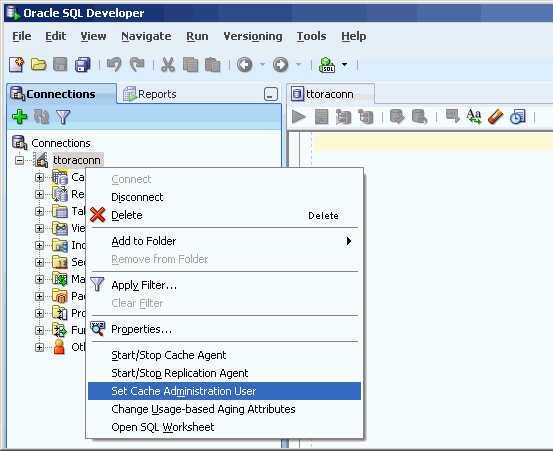
In the Prompts tab of the Setting the cache administration user dialog box, specify the cache administration user name in the Cache administration user ID field, if this field does not already contain a user name, and the corresponding password for this user in the Cache administration user password field. Then click the Apply button to set the cache administration user name and password in the TimesTen database.
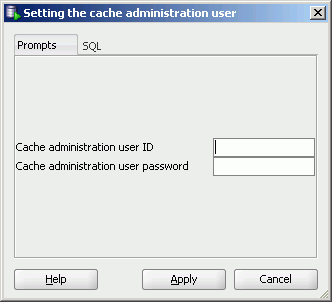
The cache administration user name and password need to be set only once in each TimesTen database that will cache Oracle data unless it needs to be changed. For example, if the TimesTen database is destroyed and re-created, or the cache administration user name is dropped and re-created in the Oracle database, the cache administration user name and password must be set again.
For more information about the cache administration user, see "Set the cache administration user name and password" in the Oracle In-Memory Database Cache User's Guide or "Create Oracle users and set privileges" in the TimesTen Cache Connect to Oracle Guide.
Configure a cache grid
Before you can create a cache group in a TimesTen database, you must perform certain tasks outside of SQL Developer using a command-line interface such as the ttIsql utility, or within SQL Developer using SQL Worksheet. See "Configuring a cache grid" in the Oracle In-Memory Database Cache User's Guide for information regarding the following tasks:
-
Create a cache grid
-
Associate the TimesTen database with the cache grid
Note:
These tasks apply only with TimesTen 11g and later.Start and stop the cache agent
After you set the cache administration user name and password, create a cache grid and associate the TimesTen database with the cache grid, you need to start the cache agent process if it is not already running. This TimesTen process performs cache operations such as loading a cache group and automatic refresh.
To start the cache agent, right-click the node that contains the name of your database connection and select Start/Stop Cache Agent.
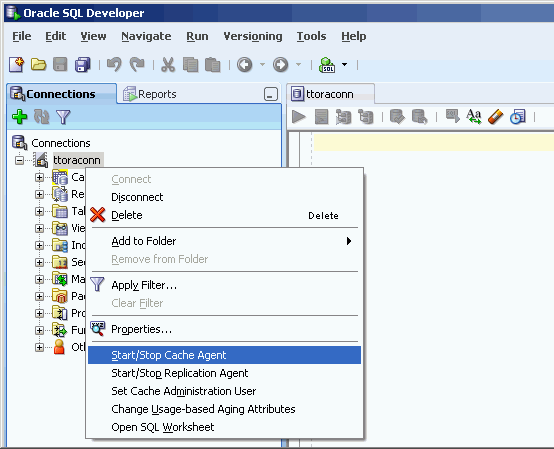
In the Starting/stopping the cache agent dialog box, put a check in the Start agent check box within the Prompts tab. Then click the Apply button to start the cache agent.
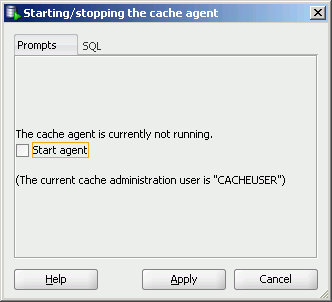
To stop a running cache agent process, right-click the node that contains the name of your database connection and select Start/Stop Cache Agent in an identical fashion as was done when starting the cache agent.
In the Starting/stopping the cache agent dialog box, put a check in the Stop agent check box within the Prompts tab. Then click the Apply button to stop the cache agent.
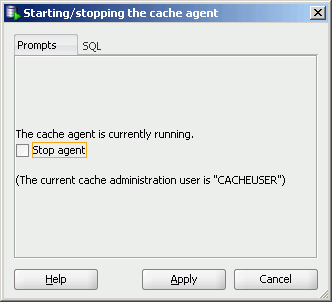
For more information about the cache agent process, see "Managing the cache agent" in the Oracle In-Memory Database Cache User's Guide or "Starting and stopping the cache agent" in the TimesTen Cache Connect to Oracle Guide.